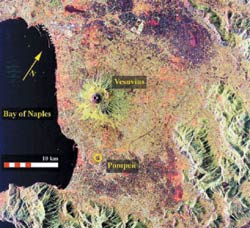|
« previous 13 of 38 next » | |||
In the 1st century A.D., Pompeii was a thriving city in Italy. It had been established as a city in 800-700 B.C. by a people called “Oscans”. Years later, it was taken over by the Greeks and finally the Romans in around 300 B.C. The location of the city had always been desirable. The climate was mild and it was a naturally beautiful spot. Perhaps even more important, though, is the fact that the volcanic Earth near Pompeii was very fertile and there was a river nearby. Fertile land was easy to farm and the river provided an easy source of water to irrigate the surrounding farmland. The river also provided a way in and out of Pompeii by boat, which allowed for trade by sea and easy communication with other nearby communities. The location of Pompeii had another advantage. It was a city located at the mouth of a river and was much easier to defend than a city on a large open body of water like the ocean. In the 1st century, and for a long time before and after, battles were fought by armies approaching on foot or by boat. It was important to see the enemy coming in order to be prepared. Being at the mouth of a river meant access to the sea, and the access was through a small passage where the citizens of Pompeii could see who else was coming or going. |
|||
